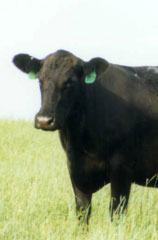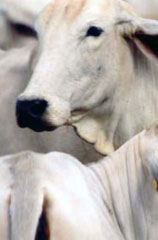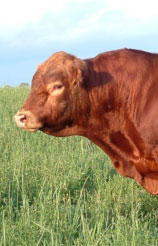Hybrid Vigour: We Are What We EatHybrid vigour (heterosis) is the term used to describe the superiority of traits carried by an animal bred from two or more genetically distinct parent breeds.
However during 2007, in light of changing climatic conditions and the transitioning of the farm to organic certification, Landtasia commenced a new cattle breeding program based on a three way rotational crossbreeding system. The aim is to establish and retain peak natural health and hybrid vigour within the herd. Three genetically diverse pure breeds are being joined – Angus, Brahman and Gelbvieh. Angus cattle were originally bred in the Aberdeen region of Scotland. Like most breeds the Angus were originally used for milk and beef production. In recent times they have become the most popular British beef breed used in temperate regions of the world. They are renowned for growth rates, feed conversion and meat quality.
Brahman
Gelbvieh These three breeds are now being joined in rotation. The resulting steers and heifers will be exceptionally healthy, vigorous, beefy and durable cattle. These breeds have been carefully and deliberately selected to exchange the utmost genetic diversity and therefore achieve high levels of hybrid vigour within the Landtasia herds. Hybrid vigour delivers gains in prized traits such as strong skeletal and muscle growth, advanced immunities, improved fertility, calving ease, lower calf mortality and greater longevity. These traits are of low heritability and are therefore difficult to improve using conventional same-breed selection methods. Just one cycle of crossbreeding can deliver significant Hybrid vigour improvements in these traits, creating truly healthy cattle. Hybrid vigour is the opposite of inbreeding. Conventional breeding techniques such as Artificial Insemination (AI) and Embryo Transfer (ET) are resulting internationally in a narrowing uniformity of “desirable genetics” (such as a high percentage of fat marbling or greater milk volume) to the extent of being excessive. This leads to significantly reduced natural gene pools, consequential inbreeding and overall less healthy and less vigourous cattle. This has happened to an alarming degree in the two major dairy breeds Holsteins and More recently, beef seed-stock producers have embraced AI and ET breeding technologies to amplify what they deemed to be desirable production traits, which like we’ve seen in dairy breeds have the potential to impact on the health traits of beef cattle in a similar manner. On the other hand, crossbreeding such as we practice at Landtasia and the benefits derived through its resultant hybrid vigour can strengthen animals’ constitutions and quality of life while at the same time making the material production gains needed to feed growing populations. Landtasia management has a policy of sourcing and producing our own top rating seed-stock bulls and cows. One of the most important factors in the successful operation of crossbreeding programs is to use the best possible genetics from each parent breed. Landtasia’s pure seed-stock herds have been sourced from superior genetics in each breed. The complimentary high quality genetic diversity in Landtasia’s natural breeding program raises the healthy dynamism of each animal. If there is truth in the biblical saying that 'you are what you eat', then the consumers of Landtasia Certified Organic Beef directly benefit from this husbandry program, which produces vigorous healthy animals that produce top quality beef, naturally. Their enhanced health traits, coupled with carefully planned rotational grazing systems and our healthy soil management, result in no chemical treatments or interventions being required for the herds – an outcome consistent with organic agriculture philosophy and the commitment Landtasia Organic Farms promises to its clients. Landtasia is a member of the Angus, Brahman and Gelbvieh Breed Societies in Australia. Written by: James Hill, Dennis Northey and Richard Graham © 2006 Landtasia Organic Farms Pty Ltd |



.jpg)
.jpg)